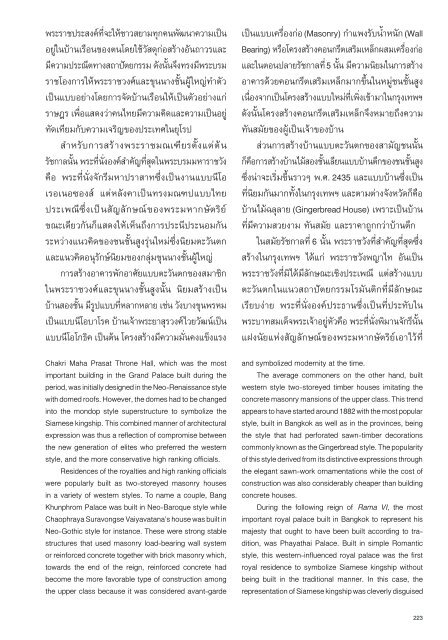บ้านเรือนถิ่นไทยในช่วงเจ็ดทศวรรษ 2489-2559
Create successful ePaper yourself
Turn your PDF publications into a flip-book with our unique Google optimized e-Paper software.
พระราชประสงค์ที่จะให้ชาวสยามทุกคนพัฒนาความเป็น<br />
อยู่ในบ้านเรือนของตนโดยใช้วัสดุก่อสร้างอันถาวรและ<br />
มีความประณีตทางสถาปัตยกรรม ดังนั้นจึงทรงมีพระบรม<br />
ราชโองการให้พระราชวงศ์และขุนนางชั้นผู้ใหญ่ทำตัว<br />
เป็นแบบอย่างโดยการจัดบ้านเรือนให้เป็นตัวอย่างแก่<br />
ราษฎร เพื่อแสดงว่าคนไทยมีความคิดและความเป็นอยู่<br />
ทัดเทียมกับความเจริญของประเทศในยุโรป<br />
สำหรับการสร้างพระราชมณเฑียรตั้งแต่ต้น<br />
รัชกาลนั้น พระที่นั่งองค์สำคัญที่สุดในพระบรมมหาราชวัง<br />
คือ พระที ่นั่งจักรีมหาปราสาทซึ่งเป็นงานแบบนีโอ<br />
เรอเนอซองส์ แต่หลังคาเป็นทรงมณฑปแบบไทย<br />
ประเพณีซึ่งเป็นสัญลักษณ์ของพระมหากษัตริย์<br />
ขณะเดียวกันก็แสดงให้เห็นถึงการประนีประนอมกัน<br />
ระหว่างแนวคิดของชนชั้นสูงรุ่นใหม่ซึ่งนิยมตะวันตก<br />
และแนวคิดอนุรักษ์นิยมของกลุ่มขุนนางชั้นผู้ใหญ่<br />
การสร้างอาคารพักอาศัยแบบตะวันตกของสมาชิก<br />
ในพระราชวงศ์และขุนนางชั้นสูงนั้น นิยมสร้างเป็น<br />
บ้านสองชั้น มีรูปแบบที่หลากหลาย เช่น วังบางขุนพรหม<br />
เป็นแบบนีโอบาโรค บ้านเจ้าพระยาสุรวงศ์ไวยวัฒน์เป็น<br />
แบบนีโอโกธิค เป็นต้น โครงสร้างมีความมั่นคงแข็งแรง<br />
Chakri Maha Prasat Throne Hall, which was the most<br />
important building in the Grand Palace built during the<br />
period, was initially designed in the Neo-Renaissance style<br />
with domed roofs. However, the domes had to be changed<br />
into the mondop style superstructure to symbolize the<br />
Siamese kingship. This combined manner of architectural<br />
expression was thus a reflection of compromise between<br />
the new generation of elites who preferred the western<br />
style, and the more conservative high ranking officials.<br />
Residences of the royalties and high ranking officials<br />
were popularly built as two-storeyed masonry houses<br />
in a variety of western styles. To name a couple, Bang<br />
Khunphrom Palace was built in Neo-Baroque style while<br />
Chaophraya Suravongse Vaiyavatana’s house was built in<br />
Neo-Gothic style for instance. These were strong stable<br />
structures that used masonry load-bearing wall system<br />
or reinforced concrete together with brick masonry which,<br />
towards the end of the reign, reinforced concrete had<br />
become the more favorable type of construction among<br />
the upper class because it was considered avant-garde<br />
เป็นแบบเครื่องก่อ (Masonry) กำแพงรับน้ำหนัก (Wall<br />
Bearing) หรือโครงสร้างคอนกรีตเสริมเหล็กผสมเครื่องก่อ<br />
และในตอนปลายรัชกาลที่ 5 นั้น มีความนิยมในการสร้าง<br />
อาคารด้วยคอนกรีตเสริมเหล็กมากขึ้นในหมู่ชนชั้นสูง<br />
เนื่องจากเป็นโครงสร้างแบบใหม่ที่เพิ่งเข้ามาในกรุงเทพฯ<br />
ดังนั้นโครงสร้างคอนกรีตเสริมเหล็กจึงหมายถึงความ<br />
ทันสมัยของผู้เป็นเจ้าของบ้าน<br />
ส่วนการสร้างบ้านแบบตะวันตกของสามัญชนนั้น<br />
ก็คือการสร้างบ้านไม้สองชั้นเลียนแบบบ้านตึกของชนชั้นสูง<br />
ซึ่งน่าจะเริ่มขึ้นราวๆ พ.ศ. 2435 และแบบบ้านซึ่งเป็น<br />
ที่นิยมกันมากทั้งในกรุงเทพฯ และตามต่างจังหวัดก็คือ<br />
บ้านไม้ฉลุลาย (Gingerbread House) เพราะเป็นบ้าน<br />
ที่มีความสวยงาม ทันสมัย และราคาถูกกว่าบ้านตึก<br />
ในสมัยรัชกาลที่ 6 นั้น พระราชวังที่สำคัญที่สุดซึ่ง<br />
สร้างในกรุงเทพฯ ได้แก่ พระราชวังพญาไท อันเป็น<br />
พระราชวังที่มิได้มีลักษณะเชิงประเพณี แต่สร้างแบบ<br />
ตะวันตกในแนวสถาปัตยกรรมโรมันติกที่มีลักษณะ<br />
เรียบง่าย พระที่นั่งองค์ประธานซึ่งเป็นที่ประทับใน<br />
พระบาทสมเด็จพระเจ้าอยู่หัวคือ พระที่นั่งพิมานจักรีนั้น<br />
แฝงนัยแห่งสัญลักษณ์ของพระมหากษัตริย์เอาไว้ที่<br />
and symbolized modernity at the time.<br />
The average commoners on the other hand, built<br />
western style two-storeyed timber houses imitating the<br />
concrete masonry mansions of the upper class. This trend<br />
appears to have started around 1882 with the most popular<br />
style, built in Bangkok as well as in the provinces, being<br />
the style that had perforated sawn-timber decorations<br />
commonly known as the Gingerbread style. The popularity<br />
of this style derived from its distinctive expressions through<br />
the elegant sawn-work ornamentations while the cost of<br />
construction was also considerably cheaper than building<br />
concrete houses.<br />
During the following reign of Rama VI, the most<br />
important royal palace built in Bangkok to represent his<br />
majesty that ought to have been built according to tradition,<br />
was Phayathai Palace. Built in simple Romantic<br />
style, this western-influenced royal palace was the first<br />
royal residence to symbolize Siamese kingship without<br />
being built in the traditional manner. In this case, the<br />
representation of Siamese kingship was cleverly disguised<br />
223


















